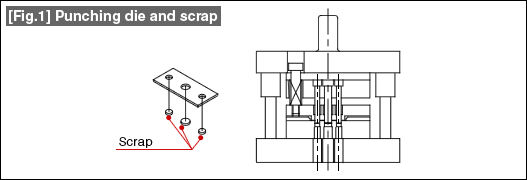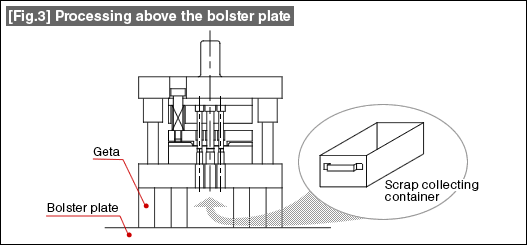#167 Problems in Punching and their Countermeasures (6) Scrap Processing in Punching
In punching operations, the processed material is separated into a part that remains on the die and a part that passes through the die and falls down. Every body will carefully handle the one that falls down if it is the final product, but very often people will handle it carelessly if it is just scrap. This frequently causes problems in making improvements. Fig. 1 shows the relationship between the die and the scrap in an example of hole punching operation. The scrap passes through the die and falls down.

Fig. 2 shows the bolster plate of the press machine.

The bottom die of the die set is fixed to this plate. In case there is no die cushion device in the press machine, a scrap dropping hole is opened as shown in the figure. The scrap or the product passes through here and gets collected in the collecting container. Although a square scrap dropping hole has been shown in the figure, round shaped holes are also used. Although it is convenient if the scrap dropping hole is large because then the scrap can fall easily, the support for the die becomes low and holding the die becomes a problem. In terms of holding the die, it is better that the scrap dropping hole is small. Normally, the scrap dropping hole has the cross-sectional shape shown in Fig. 2 (a). When the area where scrap is generated is large such as in progressive forming, etc., as a measure for dropping scrap while maintaining the strength of the bolster plate, there is the method is shown in Fig. 2 (b) in which the hole is made to have a tapered shape and the recovering area is made wider.
When the press machine is installed with a die cushion, since the die cushion comes at the part where the scrap dropping hole is present, it will not be possible to drop the scrap by passing through the bolster plate. As a result, as shown in Fig. 3, a space for collecting scrap is prepared below the die (collecting the product in some cases). At this time, the plate that is placed below the die is called a "Geta" (in Japanese, meaning wooden clogs) (also called a parallel block, spacer, etc.).

The Geta has the purpose of supporting the die so that it does not become excessively deformed due to the force of forming, and the purpose of preparing a space for collecting scrap (it is also used for adjusting the die height which is the height of the die with respect to the press machine). The scrap that is collected in this space is processed by scraping out from between the Geta. Although this processing is easy if the scrap has a suitably large size, small scraps of hole punching remain on the bolster plate, and cause damage to the bolster plate or die at the time of replacing the die. Sometimes, such scrap gets dispersed in the surroundings creating a bad environment. Because of this, in operations in which the press operating time is long (production quantity is high), instead of scraping out the scrap, it is also taken out by installing a conveyor or a chute. In the case of small quantity production, there is the method of collecting scrap by preparing a scrap collecting container as shown in the figure. While this has the advantages of it being possible to collect hole punching scrap without the scrap being scattered around, on the other hand, if this is used in large quantity production, there is the danger that work is continued without noticing that the container is full, thereby causing breaking the die.
The methods of processing scrap are not uniform, but will have to be planned considering the relationship between the shape and size of scrap and the production quantity.
- #167 Problems in Punching and their Countermeasures (6) Scrap Processing in Punching
- #166 Problems in Punching and their Countermeasures (5) Trimming of Drawn and Shaped Parts
- #165 Problems in Punching and their Countermeasures (4) Scrap Clogging in Punching
- #164 Problems in Punching and their Countermeasures (3) Bending and Twisting of Narrow Punched Parts
- #163 Problems in Punching and their Countermeasures (2) Bending due to Punching



